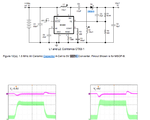pia32
Newbie level 4

I'm designing a SEPIC converter. I have everything done, power components picked, board laid out, but I'm stuck on the compensation network.
The SC4501 (Warning! The datasheet ONLY covers BOOST, not SEPIC) says that it needs an R and C in series to form the network. These components are adjusted to form a zero at the same frequency as the output (dominant?) pole to cancel it out.
The output pole frequency is at F=1/(2*PI*R_Load*C_Output), which is calculated to be at 181Hz. (20 Ohm load, 44uF output capacitance)
Therefore, the R and C in the compensation network should have a corner frequency of 181Hz. For example, I could pick a 10nF capacitor and a 88K resistor
Assuming I have done all the previous steps correctly, how does the ratio of R to C matter? I could increase C and decrease R, and the network would have the same corner freq, but the datasheet says the gain would change. How do I pick my components?
I'm way out of my depth with all this analog stuff :???:
The SC4501 (Warning! The datasheet ONLY covers BOOST, not SEPIC) says that it needs an R and C in series to form the network. These components are adjusted to form a zero at the same frequency as the output (dominant?) pole to cancel it out.
The output pole frequency is at F=1/(2*PI*R_Load*C_Output), which is calculated to be at 181Hz. (20 Ohm load, 44uF output capacitance)
Therefore, the R and C in the compensation network should have a corner frequency of 181Hz. For example, I could pick a 10nF capacitor and a 88K resistor
Assuming I have done all the previous steps correctly, how does the ratio of R to C matter? I could increase C and decrease R, and the network would have the same corner freq, but the datasheet says the gain would change. How do I pick my components?
I'm way out of my depth with all this analog stuff :???:




